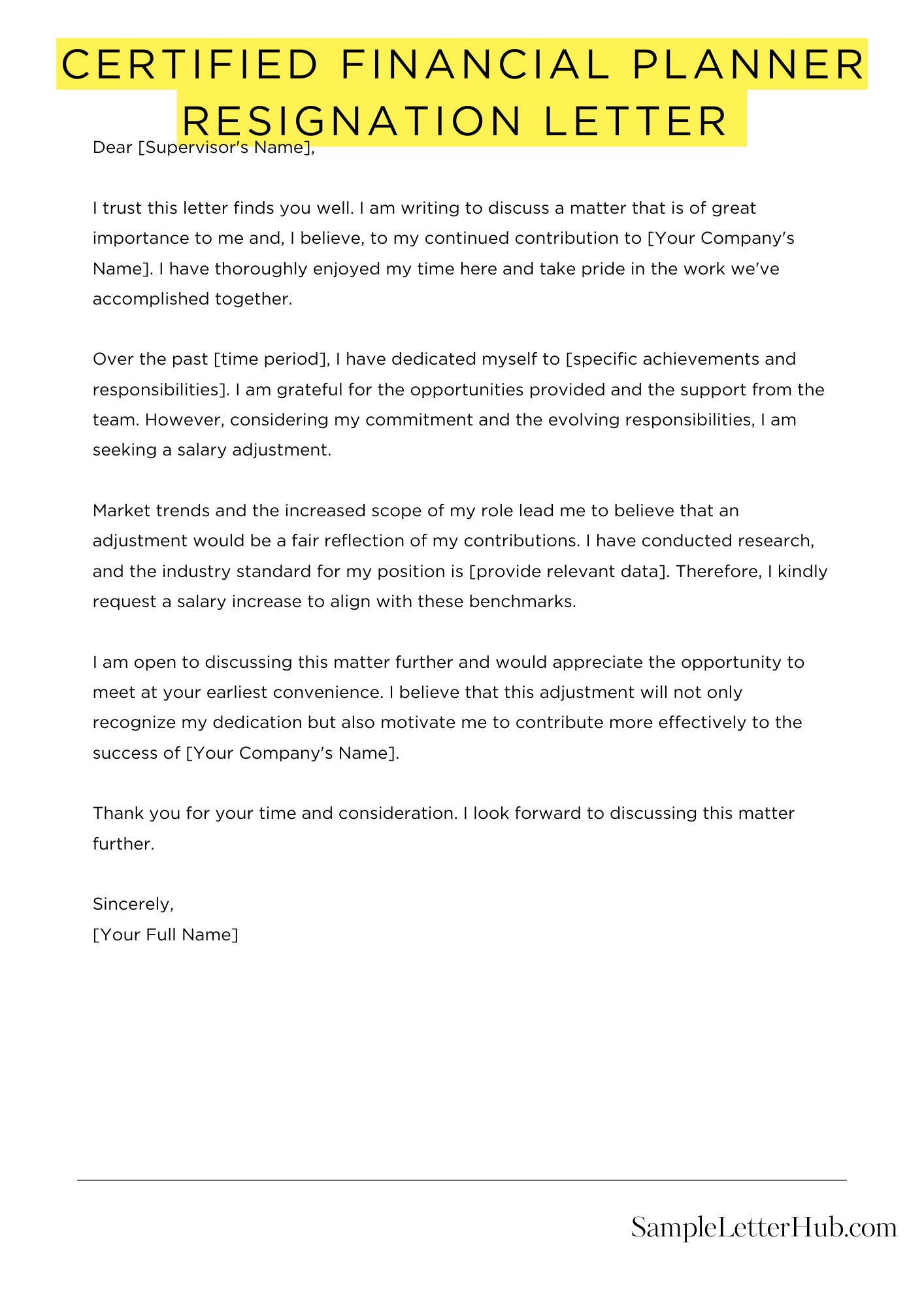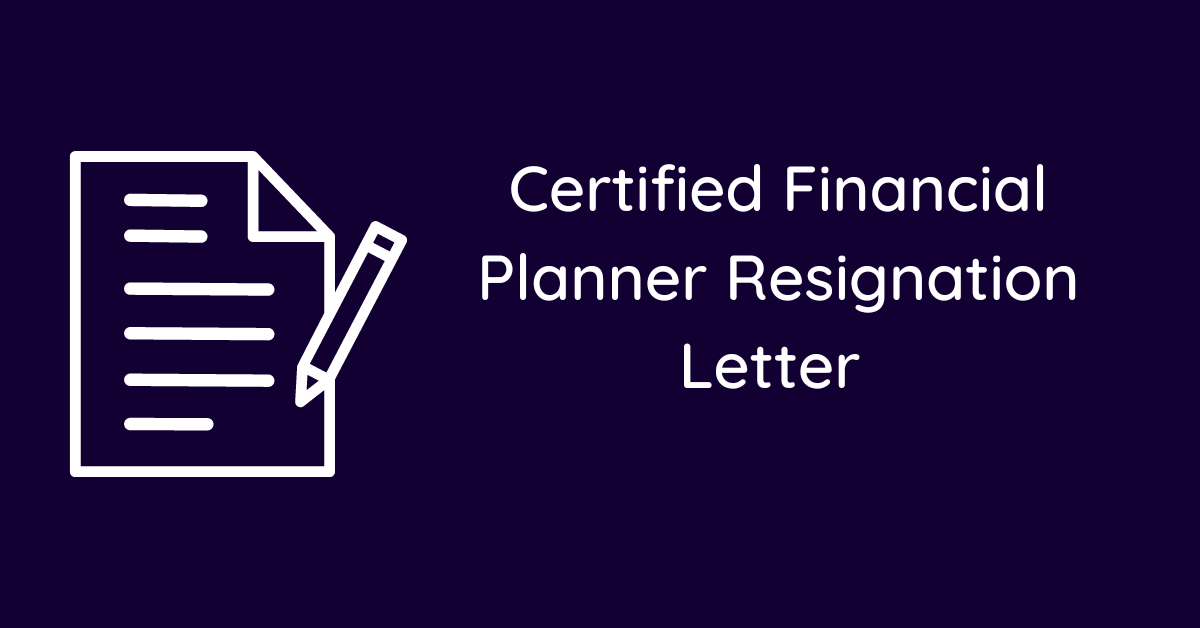If you’re a certified financial planner who’s decided to move on to new pastures, you’ll need to write a resignation letter. This letter should be clear, professional, and polite. It should also state your last date of employment and offer to help with the transition.
Writing a resignation letter can be daunting, but it doesn’t have to be. By following a few simple tips, you can write a letter that will leave a positive impression on your employer. First, keep it brief and to the point. Second, be polite and humble. Third, offer to help with the transition.
Below, we’ve included a template certified financial planner resignation letter that you can use as a starting point. Feel free to adapt it to your own needs.
Certified Financial Planner Resignation Letter
Dear [Recipient Name],
Please accept this letter as formal notification that I will be resigning from my position as a Certified Financial Planner with [Company Name], effective two weeks from today, [Date].
During my time at [Company Name], I have gained invaluable experience and knowledge in the financial planning industry. I am grateful for the opportunities I have been given and the support I have received from my colleagues.
I wish you and [Company Name] all the best in the future.
Sincerely,
[Your Signature]
Short Certified Financial Planner Resignation Letter Sample
Please accept this letter as formal notification that I am resigning from my position as Certified Financial Planner at [Company Name]. My last day of employment will be [Your Last Day]. Thank you for the opportunity to grow and learn during my time here. I wish you and the company continued success. I am happy to assist in the transition process to ensure a smooth handover of my responsibilities.
I wish you all the best with your certified financial planner resignation letter.
When it’s time to say farewell, expressing your gratitude and best wishes can make the transition smoother:

How to Write a Certified Financial Planner Resignation Letter
1. Express Your Gratitude
Begin by expressing your sincere gratitude for the opportunity to work as a Certified Financial Planner (CFP) at the firm. Highlight the valuable experiences and professional growth you’ve gained during your tenure.
2. State Your Resignation Clearly
In the second paragraph, state your intention to resign from your position as a CFP. Clearly mention your last date of employment and offer to assist with the transition process in any way possible.
3. Explain Your Reasons (Optional)
If you’re comfortable sharing your reasons for leaving, you can briefly explain them in this section. However, it’s not necessary to go into excessive detail. Focus on positive reasons, such as seeking new challenges or pursuing further education.
4. Offer Support and Assistance
Reassure your employer that you’re committed to ensuring a smooth transition during your departure. Offer to train your replacement or assist with any ongoing projects. This shows professionalism and a willingness to help.
5. End on a Positive Note
Close the letter with a positive and appreciative tone. Express your well wishes for the firm’s continued success and thank your colleagues and superiors for their support.
6 Frequently Asked Questions About Certified Financial Planner Resignation Letters
Resigning from your position as a Certified Financial Planner (CFP) can be a daunting task. To help you navigate the complexities of writing a resignation letter, we’ve compiled a list of the six most frequently asked questions and their answers.
1. What should I include in my resignation letter?
Your resignation letter should include the following key elements:
- A clear statement of your intent to resign
- Your last date of employment
- A brief expression of gratitude for the opportunity to work at the firm
- Any relevant details about your transition, such as notice period or handover arrangements
2. How should I format my resignation letter?
Your resignation letter should be written in a professional and formal tone. It should be single-spaced, with one-inch margins on all sides. Use a standard font, such as Times New Roman or Arial, and keep your letter brief and to the point.
3. What should I do if I’m not sure what to say?
If you’re struggling to find the right words, there are many resources available online that can help you write a resignation letter. You can also seek guidance from a career counselor or mentor.
4. How much notice should I give?
The amount of notice you give will depend on your specific employment contract and company policy. However, it’s generally considered good practice to give at least two weeks’ notice.
5. What if I’m leaving on bad terms?
Even if you’re leaving on bad terms, it’s important to remain professional in your resignation letter. Avoid making any negative comments about the company or your colleagues. Instead, focus on expressing your gratitude for the opportunity to work there.
6. Do I need to submit a formal resignation letter?
Yes, it’s always advisable to submit a formal resignation letter, even if you’re leaving on good terms. This will help to ensure that your resignation is processed smoothly and that you receive any outstanding benefits or payments.
Before making the decision to resign from your job, it’s essential to consider the legal aspects:
Understanding your emotions after quitting your job is important. Explore why you might be feeling sad:
Related
- Resignation letter sample
- Forced resignation letter
- Resignation letter due to going abroad
- Resignation letter due to marriage
- Resignation letter due to other opportunity
- Resignation letter due to mistake

